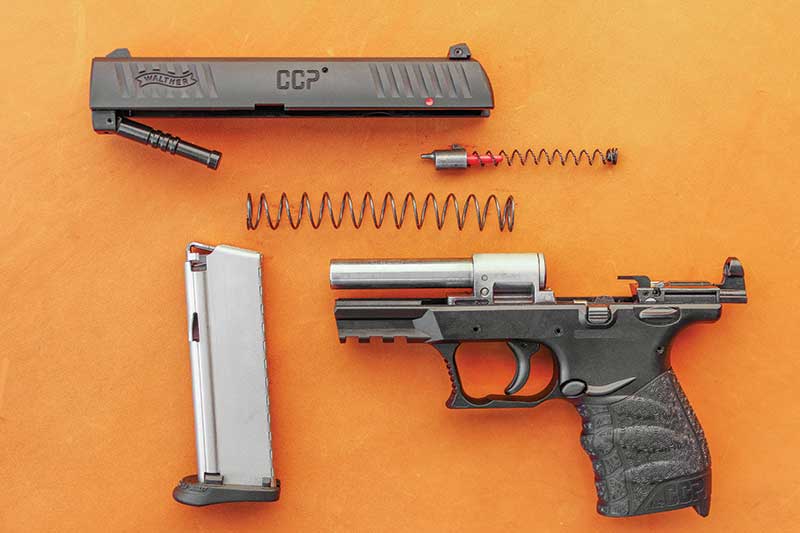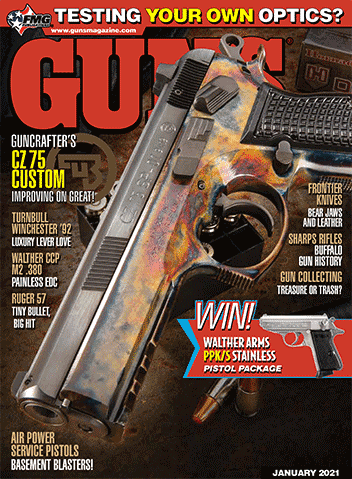Walther CCP M2 .380
A serious carry gun for ‘seasoned’ hands
Men and companies alike must be able to adapt in order to survive and the Walther Firearms Company has been adapting steadily ever since it started in 1886, manufacturing single-shot hunting and target rifles on Martini and Aydt breech-block actions.
In the late 1890s, any number of people was attempting to create the semi-automatic pistols made possible by the invention of smokeless powder but most of those early guns were large, unwieldy, awkward and commercially unsuccessful. The first two commercially successful designs to look like modern guns were both, unsurprisingly, designed by John Browning — but Walther was close behind.
Fritz Walther was able to convince his father Carl this design trend was the wave of the future and in 1908 Walther produced the little handgun that became known as the Model 1. Since then, technological advances, two World Wars, the Cold War, the division of Germany and changing consumer needs have all caused the company to reinvent itself over and over.
Millions Of Reasons
The fastest growing group in the shooting world consists of target shooters, with 17.7 million men and women taking up the sport between 2009 and 2018. Of these new target shooters, 47% are women, representing an 81% increase in female participation, according to the National Shooting Sports Foundation. An astute gun manufacturer takes note of such trends and adapts accordingly.
Meanwhile, the fastest growing segment of the U.S. population is comprised of seniors, those of us over 65. An astute gun manufacturer takes note of such trends and adapts accordingly.
Finally, concealed carry permit numbers have been on a steady and dramatic increase over the last 10 years, rising by 1.4 million in 2019 alone, with the number of women getting permits outstripping male applicants by 111%. An astute gun manufacturer takes note of such trends and adapts accordingly.
Walther Firearms is nothing if not astute.
Adapting To Now
With a semi-auto pistol, recoil, racking the slide and loading the magazine are the three hardest (think painful) aspects of shooting for those of us with weak or compromised hands. I never dreamed I would carry anything but a 1911 until arthritis set in and I noticed an increasing inability to reliably squeeze the grip safety after 200 rounds or so.
Men with worse arthritis than mine, and ladies with minimal hand strength, have trouble above all with racking the slide, even when following the precepts first laid down by William Ewart Fairbairn and Eric Anthony Sykes not long after World War I: Hold the slide stationary in the off-hand (elbow braced against your hip, if necessary) and drive the receiver forward with the dominant hand. Therefore, making a slide easier to manipulate without compromising reliability was a critical priority for Walther.
The other factor taking a severe toll on weak or compromised hands is recoil. Unfortunately, recoil is recoil, and while there are some mechanical things engineers can do to reduce perceived recoil, Newton’s laws will always apply.
Beginnings
The reason almost all police departments and the FBI mandate 9mm pistols is the round provides an excellent balance between effectiveness and ease of control. Because of this and the fact the 9mm is the most popular and common round in the world, Walther introduced their original polymer-framed CCP (Concealed Carry Pistol) back in 2014 in 9mm. It was touted as easier to rack and with less perceived recoil due to a gas-delayed blowback system they called their “Softcoil system.”
It was improved upon in 2018 with the CCP M2, which allowed the gun to be disassembled without a special tool. And now, in 2020, Walther has introduced the polymer-framed, fixed barrel, Softcoil CCP M2 in .380 ACP claiming it has “next-to-nothing recoil.”
Well, actually, yes. That’s accurate — and this is an incredibly light little gun.
How It Works
In addition to the polymer frame, the slide is manufactured out of steel-reinforced 7075 aluminum, a weight-reducing detail made possible by the much lower pressure levels of the .380. The lighter slide, coupled with a gas-delayed blowback system, allows for a lighter recoil spring, making it very easy to manually cycle. The delayed blowback system works due to a hinged piston attached to the front of the slide fitting into a gas cylinder attached to the frame, just below the fixed barrel.
And this brings us to the only tool needed to disassemble and reassemble the CCP M2 .380, a tool Walther does not supply: patience. The piston swings on its hinge so it takes a little trial and error (and your reading glasses, if you’re of a certain age) to consistently and quickly fit the piston into the gas cylinder. It’s not hard, and it requires no strength, but it takes practice before it becomes natural enough to be done quickly.
Walther lists the trigger pull at 5.5 lbs., but mine, after about 500 rounds, consistently measured a flat six. Ask me if I’m disappointed.
Two features I especially liked were the small port at the end of the slide allowing you to see if a round is in battery without a press-check, and the red cocking indicator at the rear of the slide. Those of us used to more old-fashioned pistols have certain rituals and protocols we do automatically, but for newer shooters, or a younger generation of shooters, both of those are admirable features. The thumb safety is situated on the rear of the frame where your right thumb can actually reach it without hand adjustment (and I have small hands), and the magazine release is ambidextrous.
Sighting Times Three
The sights are a standard three-dot system, with the rear sight adjustable for windage. Which brings me to one of the very best things about the CCP M2 .380: It comes with three front sights of varying heights. The gun Walther sent me had the lowest front sight installed, so it’s what I started with. My first range day, I played with it at different distances, starting at three yards and working my way out to 10. It was immediately apparent the gun was shooting high, and at 10 yards it was consistently almost 5″ high, so when I got home, I replaced the front sight with the middle one. My next range day was better, but still high. I installed the highest sight.
This is an easy switch to make. It involves a special TORX wrench (size 6IP) that comes with the gun, and if I can do it, any fool can.
With the highest sight in place, I still shot about an inch higher than my point of aim at 10 yards, but …
Because the CCP M2 .380 is intended for those of us with compromised hand strength, I wanted to get a second opinion on how the gun felt, specifically to a lady. Neither the lady I asked to give me her impressions nor her husband, nor the range master, found the gun to shoot high. And the lady in particular was exceptionally accurate and consistent in her shooting.
Watching her, the range master shook his head and said to her husband, “I’d advise you to be very nice and polite to that gal.” So I guess it was just me, and with the highest front sight on, it was not enough to bother me.
The Takeaway
What you get when you buy a CCP M2 .380 is a reliable, lightweight, very accurate carry gun with negligible recoil, comfortable to hold and shoot, a slide very easy to rack, redundant safety features, easy and tool-free disassembly in an easy-to-conceal package. In terms of demographics, it should appeal to a broad cross-section of American shooters, including serious shooters who carry regularly but especially to those of us with, uh, seasoned hands.
MSRP: $469









